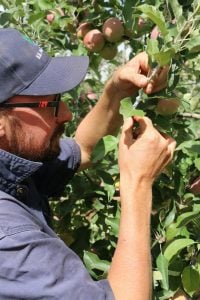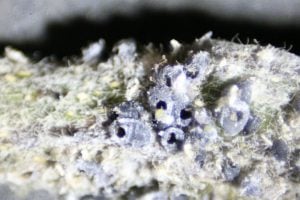Orchardist: Jeremy Smart, Batlow NSW
What are the main IPDM issues being focussed on?
Key focus through Spring and Summer has been on Woolly Apple Aphid (WAA) and Codling Moth (CM) management.
What are you doing currently with IPDM?
WAA – We’ve been keeping a close eye on WAA populations throughout our orchard by carrying out regular informal inspections whilst working in the various blocks.

IPDM Case Study grower Jeremy Smart inspecting parasitised Woolly Aphid bodies (Photo: K Dodds)
CM – This season we had some blocks under Mating Disruption (MD) and some conventionally sprayed. We monitored these with a combination of 10x and 1x lures. We also established a 3 trap line similar to what was discussed at the first training workshop just to get some experience with this approach. We informally inspected blocks for CM damage throughout the Spring and Summer and used our trap data and observations to adjust our approach to CM management as required.
What has worked well? What hasn’t?
WAA – Some of our older trees needed selective intervention with insecticide in November – December. Although this insecticide is known to disrupt the parasitic wasp Aphelinus mali, we are now (2-3 months after spraying) we are seeing plenty of parasitism by A.mali in these older blocks. It looks like this will be kept under control for the remainder of the season. In some of our younger blocks we found hotspots of WAA in Spring, but made a decision not to spray in these blocks. It has been proven to be the right decision, as the hotspots did not spread and there is now widespread parasitism in these blocks. You can actually look closely at the colonies and see the minute adult wasps moving around the canopy.

Progression of Woolly Parasitism 17 to 24th January 2019 (Photo: J Smart)
CM – We learnt part way through the season that our 10x lures in our mating disruption blocks needed to be set higher in the canopy. We weren’t catching anything. We adjusted their position, but this didn’t make much difference to the catches. At the same time we were finding low levels of moth stings on the edges of one block. So we supplemented the pheromones with some spraying. This approach seems to have kept the moth in-check.
We think our 1x traps in sprayed blocks may have been compromised by their closeness to neighbouring MD blocks thereby not trapping moth although they were present.
Our initial experience with the line of traps idea was inconclusive for us.
What would you do differently next time?
WAA – Will consider holding off spraying even in our older blocks next season. We’re also considering if it’s worth taking some parasitised WAA cuttings in the lead-up to harvest and storing these for release next Spring.

Current season parasitised WAA showing exit holes where the adult wasp has emerged (Photo: K Dodds)
CM – Will be more aware of correct trap height placement. In our non-mating disruption blocks we will make sure our 1x traps are far enough away from adjacent MD blocks so the 1x lures are not disrupted.
Any interesting learnings?
WAA – it’s not new, but A.mali can be very effective and we will look to encourage this parasitic was more in the future. We were pleased to see (in February), such good A.mali parasitism of Woolly Aphid in our insecticide sprayed older blocks. It seems that our early spray may have helped tip the balance in favour of the A.mali and the wasps were able to re-establish themselves in these blocks despite the early season insecticide.
Take home message
Our focus on these pests and use of IPM principles has produced a benefit this season. Looking forward to trying more ideas next season.
Reviewed by David Williams (Agriculture Victoria)
